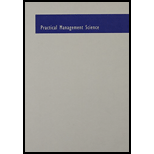
Concept explainers
a)
To determine: The way the company can maximize the profit.
Linear programming:
It is a mathematical modeling procedure where a linear function is maximized or minimized subject to certain constraints. This method is widely useful in making a quantitative analysis which is essential for making important business decisions.
b)
To use: A solver table to analyze the effect on profit of changing the minimum percentage of nitrogen required in fertilizer 1.
Linear programming:
It is a mathematical modeling procedure where a linear function is maximized or minimized subject to certain constraints. This method is widely useful in making a quantitative analysis which is essential for making important business decisions.
c)
To use: A solver table to analyze the effect of the change on the profit.
Linear programming:
It is a mathematical modeling procedure where a linear function is maximized or minimized subject to certain constraints. This method is widely useful in making a quantitative analysis which is essential for making important business decisions.
Trending nowThis is a popular solution!

Chapter 4 Solutions
Practical Management Science, Loose-leaf Version
- Say women on average take twice as long in the restroom (not including waiting times) than men. Is the 2:1 ration for flushing capacity the right ratio?arrow_forwardTo what extent does the equation for the waiting time in the queue help explain why queues for the Women's room might be longer than queues for the Men's room before 2005 in New York City?arrow_forwardBesides adding flushing capacity for the women's bathrooms versus men's bathrooms, what can be done to reduce waiting time for the restrooms?arrow_forward
- How does rework hurt a process? Give examples on how rework can hurt a process. Please provide a referencearrow_forwardHow does rework hurt a process? Give examples on how rework can hurt a process. Please provide a referencearrow_forwardWhat the different between a near miss and hazard 1. movement and contact 2. Contact 3. movementarrow_forward
- The fixed and variable costs for three potential manufacturing plant sites for a rattan chair weaver are shown: Site Fixed Cost Per Year Variable Cost per Unit 1 $700 $12.00 2 $1,000 $7.00 $2,200 $5.00 a) After rounding to the nearest whole number, site 1 is best below After rounding to the nearest whole number, site 2 is best between After rounding to the nearest whole number, site 3 is best above b) If the demand is 590 units, then the best location for the potent 3 units. and units. 600 0 60 units. g plant isarrow_forwardRefer to Table S6.1 - Factors for Computing Control Chart Limits (3 sigma) for this problem. Sampling 4 pieces of precision-cut wire (to be used in computer assembly) every hour for the past 24 hours has produced the following results: Hour R Hour X R Hour X R Hour X R 1 3.25" 0.71" 7 3.15" 0.58" 13 3.11" 0.85" 19 4.51" 1.56" 2 3.20 1.18 8 2.65 1.08 14 2.83 1.31 20 2.79 1.14 3 3.12 1.38 9 15 4. 3.39 1.31 10 5 2.97 1.17 6 2.76 0.32 3.02 0.71 3.12 1.01 2.75 1.33 16 2.74 0.50 22 11 2.73 1.17 17 2.76 1.43 23 12 2.87 0.45 18 2.64 1.24 21 2.75 1.03 3.18 0.46 2.94 1.53 24 2.54 0.97 Based on the sampling done, the control limits for 3-sigma x chart are (round all intermediate calculations to three decimal places before proceeding with further calculations): Upper Control Limit (UCL) = inches (round your response to three decimal places). Lower Control Limit (LCL) = inches (round your response to three decimal places). Based on the x-chart, the wire cutting process has been The control limits…arrow_forwardChoose a specific cars company. E.g Toyota, Volkswagen, Hyundai, Mercedes-Benz, BMW, Honda, Ford, Audi, Tesla Define a list of required machinery, equipment, workstations, offices, rest areas, materials, etc. Develop and define the location of machinery, equipment, workstations, offices, rest areas, materials. Make the distribution in the manufacturing facility the most efficient way possible. Develop a process distribution for one specific product. Explain why you consider this is the most efficient distribution for this specific manufacturing facility. demonstrate the benefits of optimizing a production line with the best distribution of its equipment and spaces. To be more productive and profitable.arrow_forward
- Provide a Synposis of the Articlearrow_forwardThe goal of understanding personality in negotiation is to better predict behavior, such as the counterparty's acceptance or rejection of a negotiation offer. One investigation used acoustic and visual cues to predict the likely behavior of a counterparty to a proposal. The best visual cue predictor of the counterparty (55%) was whether they _____. A. tilted their head B. had their arms and legs crossed C. steepled their fingers D. tapped a penarrow_forwardWomen who ask for what they want in negotiation are less well-liked than women who do not self-advocate. However, nonassertive, other-advocating women suffer a leadership backlash and are regarded as less competent because their behavior is regarded to be _____ and _____. A. high-negative feminine; low-positive masculine B. high-positive feminine; high-positive masculine C. high-negative masculine; low-negative feminine D. low-positive masculine; low-positive femininearrow_forward
 Practical Management ScienceOperations ManagementISBN:9781337406659Author:WINSTON, Wayne L.Publisher:Cengage,
Practical Management ScienceOperations ManagementISBN:9781337406659Author:WINSTON, Wayne L.Publisher:Cengage,
